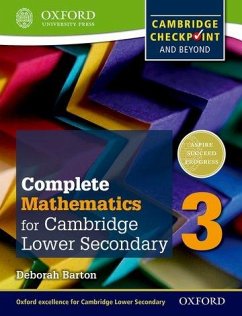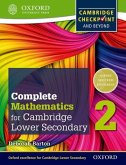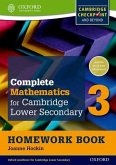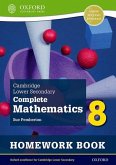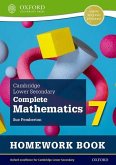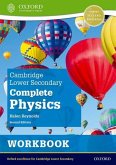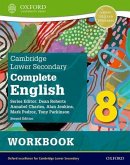Deborah Barton
Complete Mathematics for Cambridge Lower Secondary 3 (First Edition)
Deborah Barton
Complete Mathematics for Cambridge Lower Secondary 3 (First Edition)
- Broschiertes Buch
- Merkliste
- Auf die Merkliste
- Bewerten Bewerten
- Teilen
- Produkt teilen
- Produkterinnerung
- Produkterinnerung
The Complete Mathematics 3 Student Book provides support for the previous Cambridge Lower Secondary Mathematics curriculum.
Andere Kunden interessierten sich auch für
![Complete Mathematics for Cambridge Lower Secondary 2 (First Edition) Complete Mathematics for Cambridge Lower Secondary 2 (First Edition)]() Deborah BartonComplete Mathematics for Cambridge Lower Secondary 2 (First Edition)38,99 €
Deborah BartonComplete Mathematics for Cambridge Lower Secondary 2 (First Edition)38,99 €![Complete Mathematics for Cambridge Lower Secondary Homework Book 3 (First Edition) - Pack of 15 Complete Mathematics for Cambridge Lower Secondary Homework Book 3 (First Edition) - Pack of 15]() Joanne HockinComplete Mathematics for Cambridge Lower Secondary Homework Book 3 (First Edition) - Pack of 15164,99 €
Joanne HockinComplete Mathematics for Cambridge Lower Secondary Homework Book 3 (First Edition) - Pack of 15164,99 €![Cambridge Lower Secondary Complete Mathematics 8: Homework Book - Pack of 15 (Second Edition) Cambridge Lower Secondary Complete Mathematics 8: Homework Book - Pack of 15 (Second Edition)]() Sue PembertonCambridge Lower Secondary Complete Mathematics 8: Homework Book - Pack of 15 (Second Edition)192,99 €
Sue PembertonCambridge Lower Secondary Complete Mathematics 8: Homework Book - Pack of 15 (Second Edition)192,99 €![Cambridge Lower Secondary Complete Mathematics 7: Homework Book - Pack of 15 (Second Edition) Cambridge Lower Secondary Complete Mathematics 7: Homework Book - Pack of 15 (Second Edition)]() Sue PembertonCambridge Lower Secondary Complete Mathematics 7: Homework Book - Pack of 15 (Second Edition)165,99 €
Sue PembertonCambridge Lower Secondary Complete Mathematics 7: Homework Book - Pack of 15 (Second Edition)165,99 €![Cambridge Lower Secondary Complete Chemistry: Workbook (Second Edition) Cambridge Lower Secondary Complete Chemistry: Workbook (Second Edition)]() Philippa Gardom HulmeCambridge Lower Secondary Complete Chemistry: Workbook (Second Edition)12,99 €
Philippa Gardom HulmeCambridge Lower Secondary Complete Chemistry: Workbook (Second Edition)12,99 €![Cambridge Lower Secondary Complete Physics: Workbook (Second Edition) Cambridge Lower Secondary Complete Physics: Workbook (Second Edition)]() Helen ReynoldsCambridge Lower Secondary Complete Physics: Workbook (Second Edition)12,99 €
Helen ReynoldsCambridge Lower Secondary Complete Physics: Workbook (Second Edition)12,99 €![Cambridge Lower Secondary Complete English 8: Workbook (Second Edition) Cambridge Lower Secondary Complete English 8: Workbook (Second Edition)]() Mark PedrozCambridge Lower Secondary Complete English 8: Workbook (Second Edition)12,99 €
Mark PedrozCambridge Lower Secondary Complete English 8: Workbook (Second Edition)12,99 €-
-
-
The Complete Mathematics 3 Student Book provides support for the previous Cambridge Lower Secondary Mathematics curriculum.
Produktdetails
- Produktdetails
- Verlag: Oxford University Press
- Seitenzahl: 320
- Erscheinungstermin: 31. Oktober 2013
- Englisch
- Abmessung: 255mm x 197mm x 17mm
- Gewicht: 674g
- ISBN-13: 9780199137107
- ISBN-10: 0199137102
- Artikelnr.: 47870953
- Herstellerkennzeichnung
- Libri GmbH
- Europaallee 1
- 36244 Bad Hersfeld
- gpsr@libri.de
- Verlag: Oxford University Press
- Seitenzahl: 320
- Erscheinungstermin: 31. Oktober 2013
- Englisch
- Abmessung: 255mm x 197mm x 17mm
- Gewicht: 674g
- ISBN-13: 9780199137107
- ISBN-10: 0199137102
- Artikelnr.: 47870953
- Herstellerkennzeichnung
- Libri GmbH
- Europaallee 1
- 36244 Bad Hersfeld
- gpsr@libri.de
1. Fractions and indices
1.1: Working with fractions
1.2: Indices
2. Expressions and formulae
2.1: The origins of algebra and algebraic expressions
2.2: Simplifying and indices
2.3: Expanding brackets
2.4: Factorising expressions
2.5: Algebraic fractions
2.6: The product of two linear expressions
2.7: Substitution into expressions and formulae
2.8: Changing the subject of a formula
3. Shapes and mathematical drawings
3.1: Three-dimensional (3D) shapes
3.2: Constructions
3.3: Maps and scale drawings
3.4: Bearings
4. Number
4.2: Estimating square roots and cube roots
4.3: Multiplying and dividing by powers of 10
5. Measures
5.1: Length, mass and capacity
5.2: Area
5.3: Volume
5.4: Error in measurements
6. Planning, collecting and processing data
6.1: Planning and collecting data
6.2: Organising data
6.3: Calculating statistics
Review A
7. Rounding, multiplying and dividing
7.1: Rounding numbers
7.2: Estimation
7.3: Multiplying and dividing decimals
8. Equations and inequalities
8.1: Solving linear equations
8.2: Constructing and solving equations
8.3: Linear inequalities
8.4: Simultaneous equations
8.5: Trial and improvement to solve quadratic equations
9. Geometry
9.1: Properties of angles
9.2: Angles in polygons
9.3: Angles in circles
9.4: Pythagoras' theorem
9.5: Tessellations
9.6: Loci
10. Mental strategies
10.1: Word problems and strategies
10.2: BIDMAS and inverse operations
10.3: Factors
11. Compound measures
11.1: Compound measures
11.2: Real-life graphs
12. Presenting data and interpreting results
12.1: Displaying data
12.2: Scatter graphs and correlation
12.3: Processing and interpreting data
Review B
13. Ratio and proportion
13.1: Simplifying and comparing ratios
13.2: Solving ratio problems
13.3: Direct proportion
14. Sequences, functions and graphs
14.1: Linear functions
14.2: Solving simultaneous equations graphically
14.3: Equations of lines in the form y = mx +c
14.4: Real-life functions
14.5: Direct proportion
14.6: Inverse of a function
14.7: Sequences
15. Transformations
15.1: Translations
15.2: Rotations
15.3: Reflections
15.4: Enlargements
15.5: Similar triangles
15.6: Describing transformations
15.7: Combinations of transformations
16. Fractions, decimals and percentages
16.1: Profit and loss
16.2: Discounts and sales
16.3: Loans and savings
16.4: Taxes
16.5: Percentage change
17. Area, perimeter and volume
17.1: Circles
17.2: Volume of prisms and cylinders
17.3: Surface area of prisms and cylinders
18. Probability
18.1: Successive events
18.2: Relative frequency and probability
Review C
19. Quadratics
19.1: Graphs of quadratics
19.2: Expanding two brackets
19.3: Difference between two squares and using quadratics
19.4: Factorising quadratic expressions
19.5: Solving quadratic equations
19.6: Word problems
1.1: Working with fractions
1.2: Indices
2. Expressions and formulae
2.1: The origins of algebra and algebraic expressions
2.2: Simplifying and indices
2.3: Expanding brackets
2.4: Factorising expressions
2.5: Algebraic fractions
2.6: The product of two linear expressions
2.7: Substitution into expressions and formulae
2.8: Changing the subject of a formula
3. Shapes and mathematical drawings
3.1: Three-dimensional (3D) shapes
3.2: Constructions
3.3: Maps and scale drawings
3.4: Bearings
4. Number
4.2: Estimating square roots and cube roots
4.3: Multiplying and dividing by powers of 10
5. Measures
5.1: Length, mass and capacity
5.2: Area
5.3: Volume
5.4: Error in measurements
6. Planning, collecting and processing data
6.1: Planning and collecting data
6.2: Organising data
6.3: Calculating statistics
Review A
7. Rounding, multiplying and dividing
7.1: Rounding numbers
7.2: Estimation
7.3: Multiplying and dividing decimals
8. Equations and inequalities
8.1: Solving linear equations
8.2: Constructing and solving equations
8.3: Linear inequalities
8.4: Simultaneous equations
8.5: Trial and improvement to solve quadratic equations
9. Geometry
9.1: Properties of angles
9.2: Angles in polygons
9.3: Angles in circles
9.4: Pythagoras' theorem
9.5: Tessellations
9.6: Loci
10. Mental strategies
10.1: Word problems and strategies
10.2: BIDMAS and inverse operations
10.3: Factors
11. Compound measures
11.1: Compound measures
11.2: Real-life graphs
12. Presenting data and interpreting results
12.1: Displaying data
12.2: Scatter graphs and correlation
12.3: Processing and interpreting data
Review B
13. Ratio and proportion
13.1: Simplifying and comparing ratios
13.2: Solving ratio problems
13.3: Direct proportion
14. Sequences, functions and graphs
14.1: Linear functions
14.2: Solving simultaneous equations graphically
14.3: Equations of lines in the form y = mx +c
14.4: Real-life functions
14.5: Direct proportion
14.6: Inverse of a function
14.7: Sequences
15. Transformations
15.1: Translations
15.2: Rotations
15.3: Reflections
15.4: Enlargements
15.5: Similar triangles
15.6: Describing transformations
15.7: Combinations of transformations
16. Fractions, decimals and percentages
16.1: Profit and loss
16.2: Discounts and sales
16.3: Loans and savings
16.4: Taxes
16.5: Percentage change
17. Area, perimeter and volume
17.1: Circles
17.2: Volume of prisms and cylinders
17.3: Surface area of prisms and cylinders
18. Probability
18.1: Successive events
18.2: Relative frequency and probability
Review C
19. Quadratics
19.1: Graphs of quadratics
19.2: Expanding two brackets
19.3: Difference between two squares and using quadratics
19.4: Factorising quadratic expressions
19.5: Solving quadratic equations
19.6: Word problems
1. Fractions and indices
1.1: Working with fractions
1.2: Indices
2. Expressions and formulae
2.1: The origins of algebra and algebraic expressions
2.2: Simplifying and indices
2.3: Expanding brackets
2.4: Factorising expressions
2.5: Algebraic fractions
2.6: The product of two linear expressions
2.7: Substitution into expressions and formulae
2.8: Changing the subject of a formula
3. Shapes and mathematical drawings
3.1: Three-dimensional (3D) shapes
3.2: Constructions
3.3: Maps and scale drawings
3.4: Bearings
4. Number
4.2: Estimating square roots and cube roots
4.3: Multiplying and dividing by powers of 10
5. Measures
5.1: Length, mass and capacity
5.2: Area
5.3: Volume
5.4: Error in measurements
6. Planning, collecting and processing data
6.1: Planning and collecting data
6.2: Organising data
6.3: Calculating statistics
Review A
7. Rounding, multiplying and dividing
7.1: Rounding numbers
7.2: Estimation
7.3: Multiplying and dividing decimals
8. Equations and inequalities
8.1: Solving linear equations
8.2: Constructing and solving equations
8.3: Linear inequalities
8.4: Simultaneous equations
8.5: Trial and improvement to solve quadratic equations
9. Geometry
9.1: Properties of angles
9.2: Angles in polygons
9.3: Angles in circles
9.4: Pythagoras' theorem
9.5: Tessellations
9.6: Loci
10. Mental strategies
10.1: Word problems and strategies
10.2: BIDMAS and inverse operations
10.3: Factors
11. Compound measures
11.1: Compound measures
11.2: Real-life graphs
12. Presenting data and interpreting results
12.1: Displaying data
12.2: Scatter graphs and correlation
12.3: Processing and interpreting data
Review B
13. Ratio and proportion
13.1: Simplifying and comparing ratios
13.2: Solving ratio problems
13.3: Direct proportion
14. Sequences, functions and graphs
14.1: Linear functions
14.2: Solving simultaneous equations graphically
14.3: Equations of lines in the form y = mx +c
14.4: Real-life functions
14.5: Direct proportion
14.6: Inverse of a function
14.7: Sequences
15. Transformations
15.1: Translations
15.2: Rotations
15.3: Reflections
15.4: Enlargements
15.5: Similar triangles
15.6: Describing transformations
15.7: Combinations of transformations
16. Fractions, decimals and percentages
16.1: Profit and loss
16.2: Discounts and sales
16.3: Loans and savings
16.4: Taxes
16.5: Percentage change
17. Area, perimeter and volume
17.1: Circles
17.2: Volume of prisms and cylinders
17.3: Surface area of prisms and cylinders
18. Probability
18.1: Successive events
18.2: Relative frequency and probability
Review C
19. Quadratics
19.1: Graphs of quadratics
19.2: Expanding two brackets
19.3: Difference between two squares and using quadratics
19.4: Factorising quadratic expressions
19.5: Solving quadratic equations
19.6: Word problems
1.1: Working with fractions
1.2: Indices
2. Expressions and formulae
2.1: The origins of algebra and algebraic expressions
2.2: Simplifying and indices
2.3: Expanding brackets
2.4: Factorising expressions
2.5: Algebraic fractions
2.6: The product of two linear expressions
2.7: Substitution into expressions and formulae
2.8: Changing the subject of a formula
3. Shapes and mathematical drawings
3.1: Three-dimensional (3D) shapes
3.2: Constructions
3.3: Maps and scale drawings
3.4: Bearings
4. Number
4.2: Estimating square roots and cube roots
4.3: Multiplying and dividing by powers of 10
5. Measures
5.1: Length, mass and capacity
5.2: Area
5.3: Volume
5.4: Error in measurements
6. Planning, collecting and processing data
6.1: Planning and collecting data
6.2: Organising data
6.3: Calculating statistics
Review A
7. Rounding, multiplying and dividing
7.1: Rounding numbers
7.2: Estimation
7.3: Multiplying and dividing decimals
8. Equations and inequalities
8.1: Solving linear equations
8.2: Constructing and solving equations
8.3: Linear inequalities
8.4: Simultaneous equations
8.5: Trial and improvement to solve quadratic equations
9. Geometry
9.1: Properties of angles
9.2: Angles in polygons
9.3: Angles in circles
9.4: Pythagoras' theorem
9.5: Tessellations
9.6: Loci
10. Mental strategies
10.1: Word problems and strategies
10.2: BIDMAS and inverse operations
10.3: Factors
11. Compound measures
11.1: Compound measures
11.2: Real-life graphs
12. Presenting data and interpreting results
12.1: Displaying data
12.2: Scatter graphs and correlation
12.3: Processing and interpreting data
Review B
13. Ratio and proportion
13.1: Simplifying and comparing ratios
13.2: Solving ratio problems
13.3: Direct proportion
14. Sequences, functions and graphs
14.1: Linear functions
14.2: Solving simultaneous equations graphically
14.3: Equations of lines in the form y = mx +c
14.4: Real-life functions
14.5: Direct proportion
14.6: Inverse of a function
14.7: Sequences
15. Transformations
15.1: Translations
15.2: Rotations
15.3: Reflections
15.4: Enlargements
15.5: Similar triangles
15.6: Describing transformations
15.7: Combinations of transformations
16. Fractions, decimals and percentages
16.1: Profit and loss
16.2: Discounts and sales
16.3: Loans and savings
16.4: Taxes
16.5: Percentage change
17. Area, perimeter and volume
17.1: Circles
17.2: Volume of prisms and cylinders
17.3: Surface area of prisms and cylinders
18. Probability
18.1: Successive events
18.2: Relative frequency and probability
Review C
19. Quadratics
19.1: Graphs of quadratics
19.2: Expanding two brackets
19.3: Difference between two squares and using quadratics
19.4: Factorising quadratic expressions
19.5: Solving quadratic equations
19.6: Word problems

